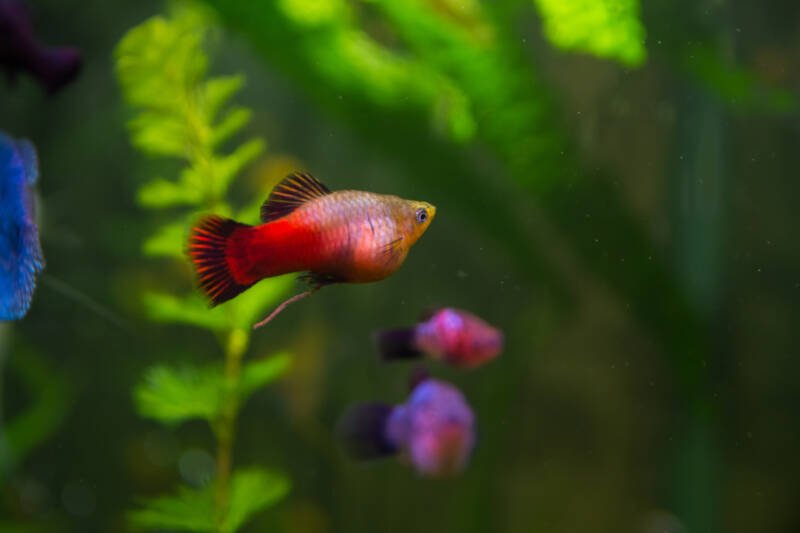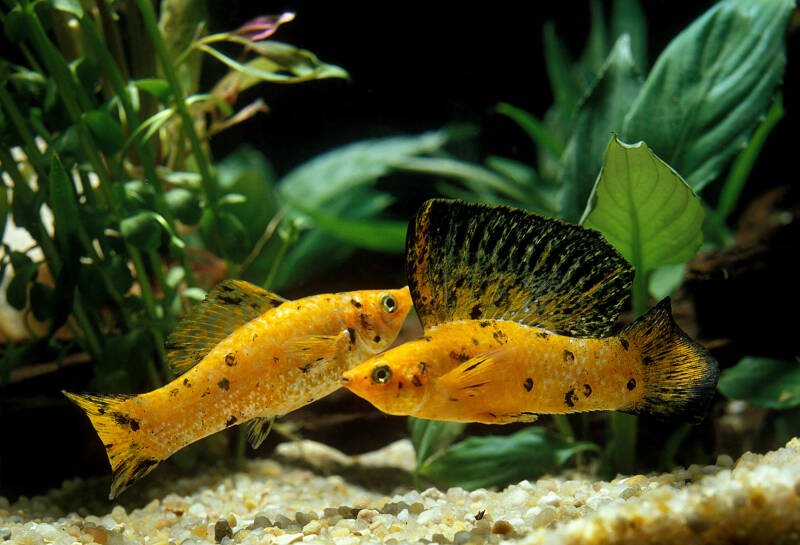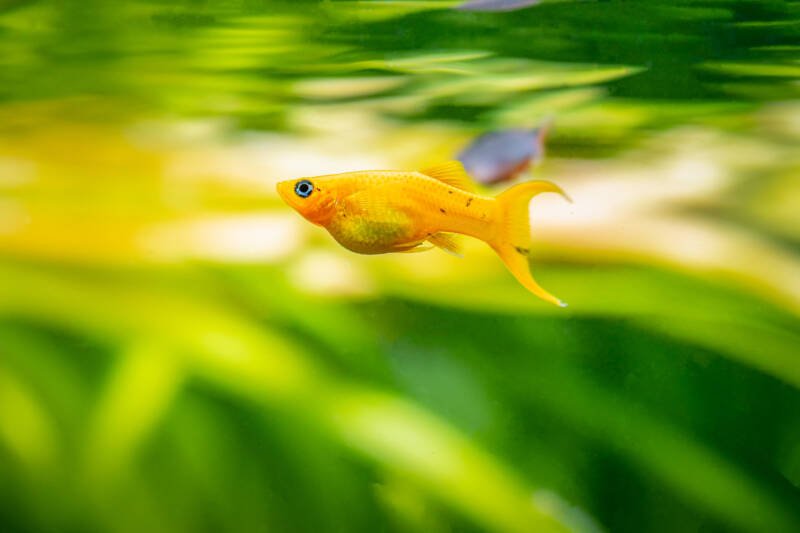While the renown of betta fish is unquestionable, the ubiquitous molly is without a doubt one popular starter fish.
For those new to aquarium keeping, the appeal of these fish is their ease of care.
Mollies are hardy, not picky when it comes to feeding time, and tolerant of the occasional “oops” events that come with a new hobby.
Poecilia sphenops, as they are known in the scientific world, come in a rainbow of colors and patterns, making a stunning tank a reality.

Breeding this species in an aquarium setting is simple and requires minimal intervention on the part of the aquarist.
In fact, you may find that you end up with more babies than you expected.
Even if you are not looking to breed your fish, you may look in your tank and wonder, “Is my molly pregnant?”
In this article, we will list physical and behavioral indications that your fish is expecting.
In addition, we will discuss different approaches to setting up a breeding tank and raising the molly fry.
These guidelines apply to other molly species, including the balloon molly, black molly, white molly, and dalmatian molly.
In this article
Molly Reproduction

To start with, let’s go over molly reproduction.
Unlike other fish common in home aquariums, mollies do not lay eggs.
The male molly internally fertilizes the female, who can store the sperm for use in multiple pregnancies.
The fertilized eggs develop into fully formed fish within the female. When the babies are ready, the female molly gives birth to free-swimming fry. As such, the molly is classified as a livebearer.
Male mollies are ready to reproduce when they are twelve months old. Females can breed at six months of age.
After they are sexually mature, mollies can continue to reproduce for two to 2.5 years.
They breed often, usually every 30 days, so you can imagine the number of babies that can result.
For how long are molly fish pregnant?
Pregnant molly fish have a gestation period of 45 to 60 days.
To how many fry do mollies give birth?
Mollies can bear anywhere from 10 to 100 fry.
You may see that younger female give birth to fewer fry, but that number should increase as the mother continues to mature.
Neither parent provides care to the babies after they are born.
Fortunately, these hardy fry are born free-swimming and are able to feed within a few hours after birth.
They instinctively hide under foliage to keep out of sight of bigger, hungry fish.
Set Up a Breeding Tank
There are three main schools of thought when it comes to setting up a breeding tank for mollies.
None of these require extensive setup, aquarist intervention, or equipment purchase.
If your goal is to raise as many fry as possible, designate a separate tank to raise the babies.
The reason for keeping the fry apart from the community tank is that mollies are not discerning when it comes to feeding; if it fits in the mouth, they will eat it.
Unfortunately, that extends to baby fry. In addition, if you keep your mollies in a community tank, their tank mates may also find the free-swimming fry to be tempting treats.
A 25- to 30-gallon tank (95-114 l) is a decent size for breeding and raising fry.
What is the best setup?
One way to keep the fry safe is to use a breeding box – a container that goes inside the breeding tank.
Place the pregnant fish into the box and allow her to give birth.
The resulting fry can safely slip through the small openings in the box into the larger part of the tank.
Another way is to simply remove the mother after she has given birth.
This is obviously more work as it involves you closely monitoring the process and removing her at the right time.
In this case, you may wish to have a small tank set up to allow her to recover before placing her back in the community tank.
Finally, you can let nature take its course and leave your fish in the main tank.
If your tank is well planted and the fry have enough places to hide, then a portion can reach adulthood, while the rest will be eaten by the mollies or their tank mates.
While this may seem cruel, it is a natural way to control the growth of your molly population.
Decorations in the Breeding Tank
Add a variety of plants with both broad and thin leaves to create an optimal environment for baby mollies.
The plants give the young fish safe places to hide. Plus, live plants encourage the growth of algae, on which your molly fry can snack.
Water Parameters
There are no specific changes to water conditions needed to prompt breeding in molly fish.
Keep the water parameters the same in the breeding tank as in the community tank.
Change out 10% to 30% of the water each week to keep the tank clean.
Molly fish have a notoriously high bioload, and routine maintenance of the water conditions in the tank will lead to healthy fish and fry.
- Temperature: 70 to 82°F (21 to 27.7°C)
- pH: 7.5 to 8.5
- Hardness: 15 to 30 dGH
Equipment
To protect your tiny fry, install a sponge filter so they will not be drawn in by the current.
Use a gravel vacuum to keep the substrate clean.
You will also need a heater and thermometer to keep the temperature of your breeding tank consistent.
Conditioning and Introducing Your Molly Fish

Prepare your female mollies for breeding by increasing the number of high-quality protein foods they receive.
While you may feed your mollies once or twice a day on a normal basis, increase the number to three times a day during the conditioning and pregnancy periods.
Small meals are best. Do not feed your fish any more than they can consume in three to five minutes. Brine shrimp or worms are always a hit.
When breeding your mollies, a harem approach works well – a ratio of three females to one male is a good place to start.
Keep in mind that a male can impregnate multiple females, and each female can store sperm for several months after they mate.
This means that even if you remove the male, your female can still become pregnant five or more times.
The result can be a tank full of baby mollies, so have a plan in place ahead of time for these little guys.
Once mating is finished, remove the male from the breeding tank. Males can occasionally chase pregnant females, and this harassment increases the female’s stress level.
Is Your Molly Pregnant?
To determine whether you have a pregnant female molly, look for certain physical signs and behavioral indicators.
Physical Signs
A pregnant molly fish will gradually develop a rounded belly as the babies inside of her grow.
Carefully observe her physical form to see that the swelling is due to her pregnancy and not to constipation or dropsy.
A healthy pregnant female will have smooth scales, as opposed to the typical “pinecone” appearance of dropsy.
For lighter-colored mollies, look for black spots on her abdomen near the anal vent.
This is the “gravid spot,” which indicates pregnancy. On some species, such as black mollies, this will be difficult to see.
Behavioral Indicators
You may notice that your female begins to consume more food.
To contrast, you should already have an idea of how much she typically ate before her pregnancy.
Pregnant females can also show more aggression.
This behavior can be exacerbated by the male, who may chase and harass a pregnant female.
If you notice this behavior, it is a good idea to remove the male before he stresses or injures the female.
Some breeders have noted that their pregnant female exhibits other unique behaviors when pregnant, such as staying close to the tank heater.
How can you tell your female is ready to give birth?
When it is close to time to give birth, your female may take to hiding more in the tank, seeking out a quiet place to bear her young.
If she is out and about, you may notice a “V” shape on her belly.
Molly Fry Care and Feeding
Once the fry are born, remove the mother from the breeding tank.
She does not provide care to the fry after birth and may consume them.
Within hours, the newborn fry are ready to eat. These little guys eat a variety of foods but remember that they have small mouths and need appropriately sized foods.
You can crush up flake food, feed them powdered fry food, vinegar eels, microworms, and newly hatched brine shrimp.
Feed them a small amount of food three to five times a day.
Keep the fry separate for 14 to 21 days to allow them to grow.
Once they are large enough that the adult mollies will not consider them as food, then they can be introduced to the community tank.
Closing Thoughts
Breeding molly fish is an activity that the beginning aquarist can take on with excellent chances for success.
Mollies readily breed in captivity with little assistance from their human friends.
There are also options for your breeding setup depending on how many baby fish you want to end up with!
Join the conversation!
Those of you who have successfully bred mollies, what recommendations do you have for the first-time breeder?